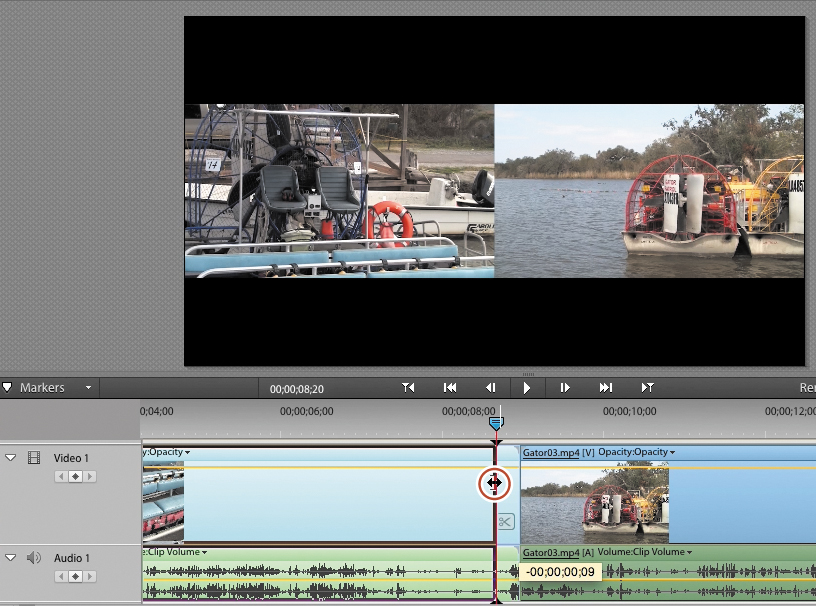5. Editing Video
Lesson overview
In Lesson 4, you learned to organize your video in the Organizer and in the Project Assets panel. In this lesson, you’ll learn how to shape that footage into a cohesive video. You’ll apply these basic editing techniques:
• Insert, delete, and rearrange clips in Quick view and Expert view
• Trim and split clips in both views
• Create a slide show with transitions
• Use Smart Trim mode to quickly remove lower-quality segments from your videos
Over the course of this lesson, you’ll piece together a short video showing an airboat trip through a Louisiana bayou. You’ll work with video and audio clips provided for this book.
This lesson will take approximately two hours. Download the project files for this lesson from the Lesson & Update Files tab on your Account page at www.peachpit.com and store them on your computer in a convenient location, as described in the Getting Started section of this book. Your Account page is also where you’ll find any updates to the chapters or to the lesson files. Look on the Lesson & Update Files tab to access the most current content.
Most of the edits will require some trimming of your imported clips, as shown here in Quick view.
Getting started
To begin, launch Adobe Premiere Elements, open the Lesson05 project, and review a final version of the movie you’ll be creating. Make sure that you have correctly copied the Lesson05 folder from your Account page onto your computer’s hard drive. See “Copying the Classroom in a Book files” in the Getting Started section at the beginning of this book.
![]() Note
Note
If you have not already downloaded the project files for this lesson to your computer from your Account page, make sure to do so now. See “Getting Started” at the beginning of the book.
1. Launch Adobe Premiere Elements. If it is already open, choose Help > Welcome Screen in the Adobe Premiere Elements menu to return to the Welcome screen.
2. In the Welcome screen, click Video Editor, select Existing Project, and click the Open folder.
3. In the Open Project dialog box, navigate to the Lesson05 folder you copied to your hard drive. Within that folder, select Lesson05_Start_Win.prel (Windows) or Lesson05_Start_Mac.prel (Mac OS), and then click Open. If a dialog box appears asking for the location of rendered files, click the Skip Previews button.
Your project file opens.
4. Choose Window > Restore Workspace to ensure that you start the lesson with the default panel layout.
Watching the guided edit
The first guided edit in Adobe Premiere Elements walks you through the various steps in editing and outputting video in Premiere Elements. Now would be a good time to work through the guided edit. To do so, choose the Editing mode that you’d like to use (either Quick or Expert), and then press the Guided button at the top the Adobe Premiere Elements window.
Choose the first guided edit, Getting Started With Premiere Elements, and work through the various steps. This will introduce you to some of the concepts covered in more detail in this chapter.

Viewing the completed movie before you start
To see what you’ll be creating in this lesson, take a look at the completed movie. You must be in Expert view to open the Project Assets panel to view the movie; if you’re not, click Expert (![]() ) to enter that view.
) to enter that view.
1. At the upper left side of the Adobe Premiere Elements window, click the Project Assets button (![]() ) to open that panel. Locate the file Lesson05_Movie.mov, and then double-click it to open the video in the preview window.
) to open that panel. Locate the file Lesson05_Movie.mov, and then double-click it to open the video in the preview window.
2. Click the Play button (![]() ) to watch the video about boating in the bayou that you’ll build in this lesson.
) to watch the video about boating in the bayou that you’ll build in this lesson.
3. When you’re done, close the preview window.
Working in the Monitor panel
When you open the project for this lesson, you’ll see multiple clips in the timeline in either Expert view or Quick view. Regardless of which view you choose, you’ll preview your work in the Monitor panel, which you’ll explore in this exercise. Although the timeline shows your entire project, the Monitor panel shows one frame of the project, and one frame only. The displayed frame is at the location of the current-time indicator (![]() ), which is sometimes called the CTI or playhead.
), which is sometimes called the CTI or playhead.
After getting familiar with the tracks in Quick view, you’ll explore the functions of the Monitor panel. This lesson starts in Quick view, so click Quick (![]() ) at the top of the Adobe Premiere Elements interface (if necessary) to shift into that view. Monitor panel functionality is very similar in both Quick and Expert views, so even if you plan on working in Expert view, you should read this section.
) at the top of the Adobe Premiere Elements interface (if necessary) to shift into that view. Monitor panel functionality is very similar in both Quick and Expert views, so even if you plan on working in Expert view, you should read this section.
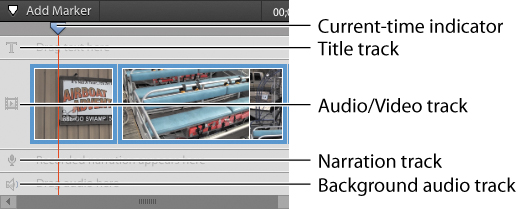
1. Select the first clip in Quick view, and note how the current-time indicator shifts to that frame and the Monitor panel displays that frame. If you click different frames in the first clip, or any clip in the Quick view timeline, the Monitor panel displays this clip. Quick view has four tracks:
• Title: All text titles go here.
• Audio/Video: This single track contains a video file and any audio in that file.
• Narration: Recorded narration is inserted on this track. Alternatively, you can drag any audio file to this track.
• Background audio: Any audio file can be added to this track.
2. If you moved the current-time indicator, return to the first clip, and click a spot close to the start of the clip. Then click the Play button (![]() ) in the Monitor panel to begin playback. As the movie is playing, notice that the timecode in the lower left corner of the Monitor panel is advancing. To pause playback, press the spacebar, or once again click the Play button, which becomes the Pause button (
) in the Monitor panel to begin playback. As the movie is playing, notice that the timecode in the lower left corner of the Monitor panel is advancing. To pause playback, press the spacebar, or once again click the Play button, which becomes the Pause button (![]() ) during playback.
) during playback.

A. Add Marker
B. Current-time indicator
C. Preview area
D. Current time (also called timecode)
E. Go to Previous Edit Point (Page Up)
F. Rewind
G. Step back (left)
H. Play/Pause toggle (spacebar)
I. Step forward (right)
J. Fast-forward
K. Go to next edit point (Page Down)
L. Render timeline
M. Fit to visible timeline ()
N. Zoom out (–)
O. Zoom control
P. Zoom in (=)
3. You can locate a specific frame in your movie by changing your position in time. Place your pointer over the timecode in the lower left corner of the Monitor panel; the Selection tool (![]() ) changes to a hand with two arrows (
) changes to a hand with two arrows (![]() ).
).
4. Drag the hand with two arrows icon to the right, advancing your video. The pointer will disappear while you’re dragging and reappear when you stop and release the mouse button. As long as you keep holding down the mouse button, you can move backward and forward through the video. This is known as scrubbing through your video.
5. You can move to a specific point in your movie by entering the time directly in the timecode field. Click the timecode in the lower left corner of the Monitor panel; it changes to an editable text field. Type 915, and then press Enter (Windows) or Return (Mac OS) to move to a point 9 seconds and 15 frames into the project. Note that you don’t have to enter the colons, just the raw numbers.
6. Click the Step Forward button (![]() ) repeatedly to advance your video one frame at a time. Video is simply a series of frames shown at a rate of approximately 30 frames per second. Using the Step Forward (
) repeatedly to advance your video one frame at a time. Video is simply a series of frames shown at a rate of approximately 30 frames per second. Using the Step Forward (![]() ) or Step Back (
) or Step Back (![]() ) button enables you to locate moments in time precisely. You also can use the Right and Left Arrow keys on the keyboard to accomplish the same functions.
) button enables you to locate moments in time precisely. You also can use the Right and Left Arrow keys on the keyboard to accomplish the same functions.
7. Click the Go To Next Edit Point button (![]() ) to jump to the first frame of the next clip. Notice in the timeline that the current-time indicator (
) to jump to the first frame of the next clip. Notice in the timeline that the current-time indicator (![]() ) jumps to the beginning of the next clip representation. Click Go To Previous Edit Point button (
) jumps to the beginning of the next clip representation. Click Go To Previous Edit Point button (![]() ) to jump to the first frame of the previous clip. Or, you can use the Page Up and Page Down keys on the keyboard to accomplish the same functions.
) to jump to the first frame of the previous clip. Or, you can use the Page Up and Page Down keys on the keyboard to accomplish the same functions.
8. Reposition the current-time indicator (![]() ) by clicking and dragging it to the left or to the right.
) by clicking and dragging it to the left or to the right.
9. While editing your project, you will spend lots of time zooming in to individual clips for trimming and effect application, and then zooming out to view larger portions of the project. The four controls on the extreme right of the Monitor panel help you accomplish this:
• Click the Zoom In button (![]() ) (=) to the right of the Zoom slider (
) (=) to the right of the Zoom slider (![]() ) to zoom in to the project. Each video clip becomes larger until it completely fills the timeline. In the diagram on the next page, note the scroll bar that appears beneath the Quick view timeline that you can click and drag to navigate around the project.
) to zoom in to the project. Each video clip becomes larger until it completely fills the timeline. In the diagram on the next page, note the scroll bar that appears beneath the Quick view timeline that you can click and drag to navigate around the project.
• Click the Fit To Visible Timeline button (![]() ) () to make all the content in the project fit within the timeline—no scrolling necessary. This is a great way to reset your project after some zoomed-in work.
) () to make all the content in the project fit within the timeline—no scrolling necessary. This is a great way to reset your project after some zoomed-in work.
• Click the Zoom Out button (![]() ) (-) to the left of the Zoom slider (
) (-) to the left of the Zoom slider (![]() ) to zoom out of the project, making each component smaller.
) to zoom out of the project, making each component smaller.
• Click and drag the Zoom slider (![]() ) (-) to customize the content viewable in the Quick view timeline.
) (-) to customize the content viewable in the Quick view timeline.
10. To move around the timeline quickly, click and drag the slider bar on the bottom of the timeline in either direction.

11. Press the Home key on your keyboard to position the current-time indicator at the beginning of the movie. Press the End key to position the current-time indicator at the end of the movie. This is useful when you want to add content to the existing sections of your movie.
Editing in Quick view
As mentioned, Adobe Premiere Elements has two editing views: Quick view for basic movie editing and Expert view for more advanced techniques. You can switch between the two views by clicking Quick (![]() ) or Expert (
) or Expert (![]() ) in the bar above the Monitor panel.
) in the bar above the Monitor panel.
Adding clips in Quick view
In Quick view, each clip is a standalone block, which makes it easy to arrange clips into coherent sequences, which is called storyboard-style editing. In Quick view, you add clips to the project via controls in the Add Media panel; all content that you add is appended to the end of the project. (You learned these techniques in Lesson 3.) Or, you can drag and drop clips from Windows Explorer (Windows) or Finder (Mac OS). When you drag and drop, you can add a clip to any position in the project. In this exercise, you’ll use this second approach.
This project contains 16 video clips, numbered in order from Gator01.mp4 to Gator16.mp4. Gator07.mp4 is not currently in the project, so you’ll add that clip in the desired location.
Everyone uses drag and drop a little differently, but here we’ll use a popular technique in which you reduce the size of the target window (in this case, Adobe Premiere Elements) and the source window (in either Windows Explorer or the Mac OS Finder), place the target window above the source window with the file you want to add visible in the source window, and then simply drag and drop. You can set up your windows whichever way works for you; the drag-and-drop instructions follow in the exercise.
1. If Adobe Premiere Elements is not already in Quick view, click the Quick view button.
2. Click the Fit To Visible Timeline button (![]() ) or press the Backslash () key so that you’re looking at the same setup as is shown below.
) or press the Backslash () key so that you’re looking at the same setup as is shown below.
3. Press the Home key to move the current-time indicator to the start of the project. Then press the Page Down key or click the Go To Next Edit Point icon in the Monitor panel six times to move to the start of the seventh clip. This is where you want to drag Gator07.mp4. Note that this step isn’t absolutely necessary; the current-time indicator doesn’t have to be where you add the clip, although it does simplify the operation.
4. In Windows Explorer (Windows) or Finder (Mac OS), navigate to the Lesson05 folder you copied to your hard drive. Within that folder, select Gator07.mp4.
![]() Note
Note
To see the names of the files on the timeline in Quick view, either switch over to Expert view for a moment, or choose Window > Info, which opens the Information window. Then click any clip in the timeline to view the filename and other information about the clip.
5. Drag Gator07.mp4 to the current-time indicator between the sixth and seventh clips in the timeline. Until you release the pointer, Adobe Premiere Elements displays Trim view in the Monitor panel, which shows the last frame of the clip immediately preceding where you’re about to drop the file and the first frame of the clip immediately after where you’re about to drop the file. This makes it easy to see if you’re dropping the clip in the right location; if your Monitor panel shows the same frames as you see below, then you are, so release the clip.
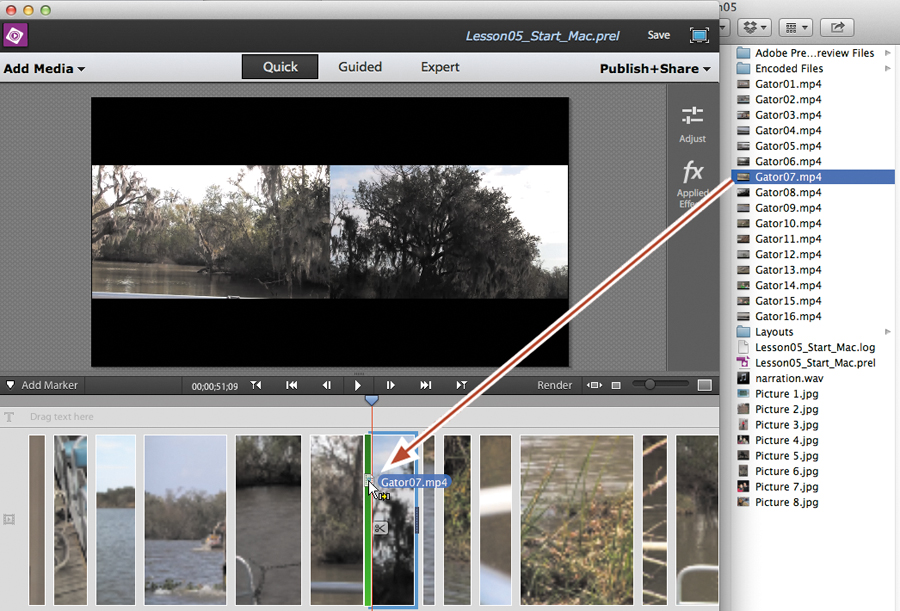
Adobe Premiere Elements adds the clip at the selected location and moves all subsequent clips to the right.
6. Choose File > Save As, and save the project as Lesson05_working.prel.
Moving clips in Quick view
Working in Quick view makes it easy to move clips in your movie. If you hover the pointer over the clips at the start of the project, you see that the current order is Gator01.mp4, Gator02.mp4, Gator04.mp4, Gator05.mp4, and Gator03.mp4. You have two options for placing the clips in the proper order: moving Gator03.mp4 two clips to the left or moving Gator04.mp4 and Gator05.mp4 one clip to the right. Let’s use both approaches.
1. Hover your pointer over Gator03.mp4 to confirm that it is the fifth clip in the project. Then click to select it, and drag it to the intersection of the second and third clips. Release the mouse when the green vertical line appears at the target location. Note: Trim view in the Monitor panel shows the last frame of the clip immediately preceding where you’re about to drop the file and the first frame of the clip immediately after where you’re about to drop the file. When you release the pointer, Adobe Premiere Elements inserts the clip at the selected location and moves all subsequent clips to the right.

2. At the bottom left of the window, click Undo (![]() ) to undo that operation. Alternatively, you can choose Edit > Undo from the Adobe Premiere Elements menu, or press the old standbys Ctrl+Z (Windows) or Command+Z (Mac OS).
) to undo that operation. Alternatively, you can choose Edit > Undo from the Adobe Premiere Elements menu, or press the old standbys Ctrl+Z (Windows) or Command+Z (Mac OS).
We said we’d use two approaches to moving clips. Now we’ll fix the problem the other way.
![]() Note
Note
Although not shown in this exercise, a transition following a scene moves with the scene.
3. Move the third and fourth clips in the project, Gator04.mp4 and Gator05.mp4, one position to the right. To select multiple adjacent clips, press the Shift key and click the clips, release the Shift key, and drag them one position to the right, which is the intersection between Gator03.mp4 and Gator06.mp4. Release the pointer when the vertical line at the back end of the two clips appears at the desired position.

Deleting clips in Quick view
As your project develops, you may find that you want to delete clips that you’ve added to your project.
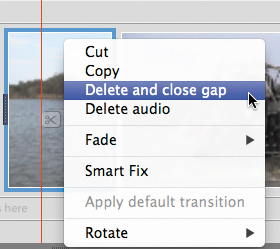
![]() Note
Note
When a clip is deleted from Quick view, any transitions associated with the clip, either before or after, are also deleted.
To delete a clip, right-click it in Quick view, and then choose one of the following from the context menu:
• Cut to delete the clip and move all clips following the deleted clip to the left to close the gap. This is the default behavior when deleting clips in Adobe Premiere Elements and is called a ripple deletion.
• Delete And Close Gap to delete the clip and move all clips following the deleted clip to the left to close the gap.
• Delete Audio to delete the audio in the clip but leave the video in place.
Trimming clips in Quick view
In addition to moving clips around, you may also want to shorten your clips by trimming frames from the beginning and end. In this section, you’ll accomplish this task.
In editing terminology, the beginning of each clip is called the In point and the end of a clip the Out point. When you adjust the In and Out points, you don’t actually delete frames from the file on your hard drive; you simply point to different frames to start and end playback of that clip on the timeline. When you trim a clip in Adobe Premiere Elements, you are simply changing the In and Out points.
It’s a rare project that doesn’t have some frames that could use trimming, and this one is no exception. Let’s trim three clips: Gator02.mp4, Gator03.mp4, and Gator14.mp4. You’ll begin by zooming into the project, making it much easier to see what you’re doing.
1. Click the Fit To Visible Timeline icon (![]() ) at the lower right of the Monitor panel, or press the Backslash key (). Then press the Zoom In (
) at the lower right of the Monitor panel, or press the Backslash key (). Then press the Zoom In (![]() ) icon (or the = key) three times.
) icon (or the = key) three times.
2. Drag the current-time indicator to the right edge of Gator02.png, right around 8:20 in the timeline. Then drag the current-time indicator to the end of the clip. Notice how the camera dropped toward the end of the clip? You’ll trim that out.
3. Move the current-time indicator back to 8:20.
4. Hover the pointer over the right edge of Gator02.mp4. The pointer will convert to the drag pointer (![]() ).
).
5. Click and drag the right edge of Gator02.mp4 to the left until it snaps to the current-time indicator at 00;00;08;20, and then release the mouse button.
You’ve just trimmed the last few frames from the edge of the clip.
Notice that while you drag the edge, the Monitor panel changes to Trim view, showing the clip you’re trimming on the left and the next clip in the timeline on the right. As you drag the right edge to the left, Trim view updates the frame on the left, making it easy to see the edge of the clip that you’re trimming.
Also notice the trim icon (![]() ) that appears on the top right of the clip. This lets you know that the clip has been trimmed.
) that appears on the top right of the clip. This lets you know that the clip has been trimmed.

6. The same kind of camera drop occurred in the next clip, starting at about 00;00;15;10, so move the current-time indicator to 00;00;15;10.
7. Hover the pointer over the right edge of Gator03.mp4. The pointer converts to the drag pointer (![]() ).
).
8. Click and drag the right edge of Gator03.mp4 to the left until it snaps to the current-time indicator at 00;00;15;10, and then release the mouse button.
You’ve just trimmed the last few frames from the edge of the clip.
9. Grab the slider on the bottom of the timeline, and drag it to the right until Gator14.mp4 appears in full.
This is the clip with the girl in a green shirt, holding the baby alligator in the prescribed manner that’s safe for her and won’t hurt the baby alligator in any way. Let’s trim some frames from the start of the clip.
10. Move the current-time indicator to the point in the clip where the girl is just starting to open her mouth, which should be around 00;01;43;15.
11. Hover the pointer over the left edge of Gator14.mp4. The pointer converts to the drag pointer pointing in the other direction (![]() ).
).
![]() Note
Note
You don’t need to place the current-time indicator at the trim point. You can simply click and drag the edge to the new location. Placing the current-time indicator at that location and then snapping to it as demonstrated is just a bit more precise, and helps make sure that you reproduce the results as you see them.
12. Click and drag the left edge of Gator14.mp4 to the right until it snaps to the current-time indicator, and then release the pointer. Adobe Premiere Elements trims the first few frames from the start of Gator14.mp4.
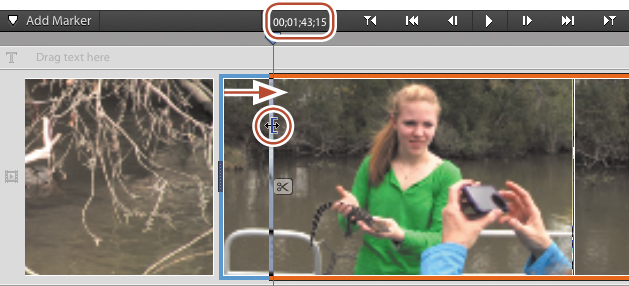
![]() Note
Note
You may not see Trim view on all computers, particularly Mac notebooks. If you don’t, make sure you’ve got the latest graphics card driver for your computer.
13. Drag the current-time indicator slowly to the end of Gator14.mp4. Towards the end, around 1:49:20, is a near perfect specimen of the impatient teenage eye roll, American edition, 2013. Pretty impressive, right? While it’s tempting to leave this in for posterity, let’s remove it by dragging the current-time indicator to around 00;01;48;00, hovering over the right edge and then clicking and dragging the edge to the left until it snaps to the current-time indicator.
Using the Split Clip tool in Quick view
The Split Clip tool allows you to divide single clips into multiple clips. You can use this tool to split a clip into sections so you can delete one of them, which sometimes is more convenient than trimming. You can also use the tool to split a long clip into separate clips to edit them individually, which is what you’ll do in this exercise.
1. Move the current-time indicator to around timecode 00;01;30;00, which should be in the clip Gator12.mp4, one of the few clips with an actual wild alligator in it (apparently, January isn’t prime alligator viewing season). As you drag the current-time indicator to the right, you’ll notice that the alligator drifts out of view around 00;01;30;26, and then back into view until it submerges later in the shot. Let’s split this clip and turn it into two clips that you can edit separately.
2. Position the current-time indicator at 00;01;30;26. You may need to click the Zoom Out button (![]() ) once to see the whole clip in the timeline.
) once to see the whole clip in the timeline.
3. Click the file Gator12.mp4 to select it. Clicking the file is important, because if you don’t, Adobe Premiere Elements will split all content at that location, which isn’t important here, but may not be what you want at other times.
4. Hover the pointer over the scissors icon (![]() ) attached to the current-time indicator until it turns white, and then click the icon, or press Ctrl+K (Windows) or Command+K (Mac). Adobe Premiere Elements splits the clip at that location.
) attached to the current-time indicator until it turns white, and then click the icon, or press Ctrl+K (Windows) or Command+K (Mac). Adobe Premiere Elements splits the clip at that location.

You now have two Gator12.mp4 clips in the timeline.

5. When you’re finished reviewing the movie, choose File > Save As.
6. In the Save Project dialog box, name the file Lesson05_working.prel, and save it in your Lesson05 folder. If the Confirm Save As dialog box appears, click Yes.
Working in Expert view
Although you can perform most basic editing tasks in Quick view, you’ll use Expert view for many advanced editing tasks, especially those that involve layering, which means having multiple clips in the project at the same location. Before you begin working with Expert view, follow the instructions at the start of this lesson to load Lesson05_Start_Win.prel (Windows) or Lesson05_Start_Mac.prel (Mac OS) if it’s not loaded already.
1. To enter Expert view, click the Expert button (![]() ) at the top of the Monitor panel.
) at the top of the Monitor panel.
2. If necessary, click the Collapse-Expand Track triangles on Video 1 and Audio 1 to show the content in those tracks.
![]() Note
Note
For information on zooming in to and out of the timeline and resizing content within the timeline, see “Working in the Monitor panel” earlier in this lesson.
3. If necessary, click the Zoom In button (![]() ) on the extreme right of the Monitor panel once to approximate what you see here.
) on the extreme right of the Monitor panel once to approximate what you see here.
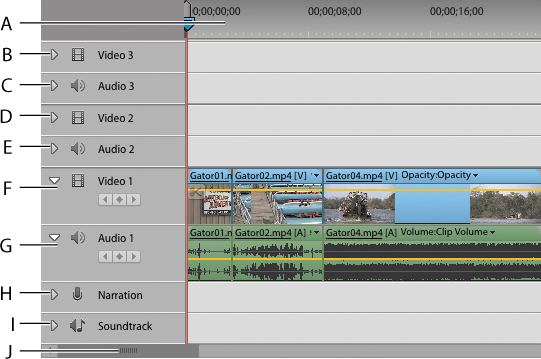
A. Time ruler
B. Video track 3
C. Audio track 3
D. Video track 2
E. Audio track 2
F. Collapse-Expand video track
G. Collapse-Expand audio track
H. Narration track
I. Soundtrack
J. Timeline slider
![]() Note
Note
If you’re going back and forth between Quick and Expert views, keep in mind that the Video 1/Audio 1 track corresponds with the audio/video track in Quick view, whereas Video 3 corresponds with the Title track in Quick view. If audio or video is placed on any other tracks in Expert view, it won’t appear in Quick view. If non-title content is placed on Video 3, it will appear in Quick view, but you won’t have a track left for titles.
Adding and deleting tracks
The timeline consists of vertically stacked tracks in which you arrange media clips. Tracks let you layer video or audio and add compositing effects, picture-in-picture effects, overlay titles, soundtracks, and more.
You perform most of your editing in the Video 1 and the Audio 1 tracks. Directly above these are the Video 2 and Audio 2 tracks. Note that the stacking order of video tracks is important. The Monitor panel displays (and Adobe Premiere Elements produces) the tracks from the top down. Accordingly, any opaque areas of the clip in the Video 2 track will cover the view of the clip in the Video 1 track.
Conversely, the clip in the Video 1 track will show through any transparent areas of the clip in the Video 2 track. Below the Video 1 and Audio 1 tracks are two more audio tracks, Narration and Soundtrack. Audio tracks are combined in playback, and their stacking order is not relevant.
Adobe Premiere Elements starts with three open video tracks (Video 1, Video 2, and Video 3) and five open audio tracks (Soundtrack, Narration, Audio 1, Audio 2, and Audio 3), which should be sufficient for most projects. Should you need additional video or audio tracks, you can add them by choosing Timeline > Add Tracks. You can delete any empty tracks by choosing Timeline > Delete Empty Tracks.
Changing the height of tracks
You can change the height of each track in the timeline for better viewing and easier editing of your projects. As a track enlarges, it displays more information. Let’s adjust the height of the Video 1 track.
1. If necessary, scroll down in the timeline to see the Video 1 track.
2. Right-click on any open area in the timeline, and choose Track Size > Small, Track Size > Medium, or Track Size > Large to change the track size for all tracks in the timeline.
3. To customize a specific track, at the left side of the timeline, click the disclosure triangle to the left of the Video 1 track icon. Then place the pointer between the Audio 2 and Video 1 tracks. Your pointer should change to two parallel lines with two arrows (![]() ). Drag up to expand the height of Video 1.
). Drag up to expand the height of Video 1.
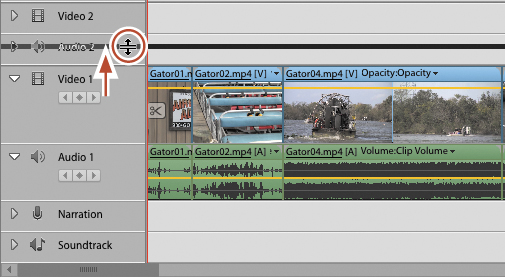
Customizing track views
You can display clips in the timeline in different ways, depending on your preference or the task at hand. You can display a thumbnail image at just the beginning of a clip, at the head and tail of a clip, or along the entire duration of a clip, as shown above. For an audio track, you can display or hide the audio waveform. Toggle through the various views of the video and audio tracks until you find the one that best suits your eye and working style.
To get a good look at the various styles, it’s best to click the Zoom In button (![]() ) on the right of the Monitor panel until only three or four clips are showing on the timeline.
) on the right of the Monitor panel until only three or four clips are showing on the timeline.
By default, Adobe Premiere Elements displays the first frame and the last frame of the clip, or the head and tail, with a blue region in between.

1. To change the default display, click the Set Video Track Display Style button (![]() ) to the left of the Video 1 track. Click the button four times to see all four styles. Choose the style that you like best.
) to the left of the Video 1 track. Click the button four times to see all four styles. Choose the style that you like best.
2. To change the audio view, click the Set Audio Track Display Style button (![]() ) to the left of the Audio 1 track twice.
) to the left of the Audio 1 track twice.
Editing in Expert view
One of the most significant differences between Expert and Quick views is that the Project Assets panel exists in Expert view, but not in Quick view. When you’re working in Quick view, all content imported via the Add Media controls is immediately placed at the end of the project in the Quick view timeline. In Expert view, all content imported via the Add Media controls is placed in the Project Assets panel, where you can add the content to your project at any location. So you’ll start there, adding content from the Project Assets panel to the project.
Adding clips in Expert view
If you worked through the exercises in Quick view, recall that the initial project was missing the clip Gator07.mp4. For your first exercise in Expert view, you’ll add that to the project, between Gator06.mp4 and Gator08.mp4. Keep in mind that the Project Assets panel is available only in Expert view, so if you’re not in Expert view, click the Expert button at the top of the Monitor panel.
1. At the lower right of the Monitor panel, click the Fit To Visible Timeline button (![]() ) or press the Backslash () key to fit the project in the timeline.
) or press the Backslash () key to fit the project in the timeline.
2. At the upper left of the Adobe Premiere Elements window, click Project Assets (![]() ) to open that panel.
) to open that panel.
3. Click Gator07.mp4, and drag it to the intersection of the files Gator06.mp4 and Gator08.mp4. Hold the clip for a moment, and notice how Adobe Premiere Elements moves Gator08.mp4 and all subsequent clips to the right to make space for Gator07.mp4.
Also, note how the Monitor panel changes to Trim view to show the last frame of Gator06.mp4 on the left and the first frame of Gator08.mp4 on the right. Before releasing the mouse, drag Gator07.mp4 a bit further to the right, into Gator08.mp4, to see how this is reflected in the Monitor panel. This view makes it simple to tell when you’re not dropping the clip in the right place. When you’re ready, release the mouse button to complete the edit.

Now you’ll learn a different technique for adding clips to the timeline.
4. At the bottom left of the Adobe Premiere Elements window, click the Undo button (![]() ), or otherwise undo the edit.
), or otherwise undo the edit.
5. Move the current-time indicator between Gator06.mp4 and Gator08.mp4, which should be around 00;00;51;09.
6. In the Project Assets folder, click Gator07.mp4 to select it. Then, while watching the timeline, press the comma key (,) on your keyboard. Adobe Premiere Elements adds Gator07.mp4 to the timeline at the current-time indicator.
Moving clips in Expert view
Now you’ll fix the order of clips in Expert view. If you hover your mouse over the clips at the start of the project, you’ll see that the current order is Gator01.mp4, Gator02.mp4, Gator04.mp4, Gator05.mp4, and Gator03.mp4. As before, you have two options for placing the clips in the proper order: moving Gator03.mp4 two clips to the left or moving Gator04.mp4 and Gator05.mp4 one clip to the right. Let’s try both approaches.
1. Click and hold to select Gator03.mp4, and then press the Alt (Windows) or Option (Mac OS) key. You’ll see the rearrange pointer (![]() ). Drag Gator03.mp4 until the front edge of the clip touches the intersection between Gator02.mp4 and Gator04.mp4. Watch the Trim view in the Monitor panel to make sure that the front of Gator03.mp4 is at the intersection between the two clips. Wait a moment for Adobe Premiere Elements to move all the clips to the right to make a space for Gator03.mp4. Then release the pointer.
). Drag Gator03.mp4 until the front edge of the clip touches the intersection between Gator02.mp4 and Gator04.mp4. Watch the Trim view in the Monitor panel to make sure that the front of Gator03.mp4 is at the intersection between the two clips. Wait a moment for Adobe Premiere Elements to move all the clips to the right to make a space for Gator03.mp4. Then release the pointer.

![]() Note
Note
Using the rearrange pointer is not supposed to leave a gap in the timeline, but did so during the writing of this book. Adobe says it will address this issue in the short term, so we’ve documented the way it’s supposed to work, and caution you that the gap may appear.
2. If Adobe Premiere Elements leaves a gap where Gator03.mp4 used to be, right-click the gap, and choose Delete And Close Gap.
3. At the bottom left of the Adobe Premiere Elements window, click Undo (![]() ) twice to undo those operations.
) twice to undo those operations.
Now you’ll try the other approach: moving Gator04.mp4 and Gator05.mp4 to the right.
4. To select multiple adjacent clips, press the Shift key and click the clips, in this case Gator04.mp4 and Gator05.mp4, and without releasing the Shift key, press the Alt (Windows) or Option (Mac OS) key. Then you can release the Shift key and drag the selected clips (pay attention here) until the left edge of the two clips is in the intersection between Gator03.mp4 and Gator06.mp4.
![]() Note
Note
Although not shown in this exercise, in Expert view, any transitions before or after a single clip are deleted during a move. Transitions between multiple adjacent clips that were moved survive the move.
5. Watch the Trim view in the Monitor panel to make sure that you’re dropping the two clips at the desired location. Wait a moment for Adobe Premiere Elements to move all the clips to the right to make a space for the two clips. Then release the mouse button.

6. If Adobe Premiere Elements leaves a gap where Gator04.mp4 and Gator05.mp4 were previously located, right-click the gap, and choose Delete And Close Gap.
Deleting clips in Expert view

![]() Note
Note
When a clip is deleted in Expert view, any transitions associated with the clip, either before or after, are also deleted.
When you’re deleting clips in Expert view, you have a lot more control over the results than you do in Quick view. This section describes the various options.
To delete a scene, right-click it in the Expert view, and then choose one of the following from the context menu:
• Cut deletes the clip and moves all clips following the deleted clip to the left to close the gap. This is the default behavior when deleting clips in Adobe Premiere Elements and is called a ripple deletion.
• Copy copies the clip and any effects or other adjustments made to the clip.
• Paste Effects And Adjustments pastes any effects or other adjustments from the source clip to the target clip. This operation can be exceptionally useful when you’re applying an effect like an exposure correction to a number of clips from the same scene, and you’ll explore it further in Lesson 6.
• Delete deletes the clip but leaves a gap at the clip’s former location.
• Delete And Close Gap does the same thing as Cut; it deletes the clip and moves all clips following the deleted clip to the left to close the gap.
• Delete Audio deletes the audio in the clip but leaves the video in place.
• Delete Video deletes the video in the clip but leaves the audio in place.
• Replace Clip From Project Assets replaces a selected clip on the timeline with a clip selected in the Project Assets panel.
Trimming clips in Expert view
As discussed in the “Editing in Quick view” section, every clip in the timeline has a beginning and an end. In addition to moving clips around, you may also want to shorten clips by trimming frames from the beginning and end. Here’s how you’ll accomplish this task.
In editing terminology, the beginning of each clip is called the In point and the end of a clip the Out point. When you adjust the In and Out points, you don’t actually delete frames from the file on your hard drive; you simply point to different frames to start and end playback of that clip on the timeline. When you trim a clip in Adobe Premiere Elements, you’re simply changing the In and Out points.
It’s a rare project that doesn’t have some frames that could use some trimming, and this one is no exception. In this exercise you’ll trim three clips: Gator02.mp4, Gator03.mp4, and Gator14.mp4. You’ll begin by zooming in to the project.
1. Click the Fit To Visible Timeline icon (![]() ) at the lower right of the Monitor panel, or press the Backslash key (). Then press the Zoom in icon (
) at the lower right of the Monitor panel, or press the Backslash key (). Then press the Zoom in icon (![]() ) (or the = key) three times.
) (or the = key) three times.
2. Drag the current-time indicator to the right edge of Gator02.png, right around 8:20 in the timeline (or click the timecode on the bottom left of the Monitor panel, type 820, and press Enter or Return). Then drag the current-time indicator to the end of the clip. Notice how the camera dropped towards the end of the clip? You’ll trim that out.
3. Move the current-time indicator back to 8:20.
4. Hover the pointer over the right edge of Gator02.mp4. The pointer will convert to the drag pointer (![]() ).
).
5. Click and drag the right edge of Gator02.mp4 to the left until it snaps to the current-time indicator at 00;00;08;20, and then release the mouse button. You’ve just trimmed the last few frames from the edge of the clip.
Notice that while you drag the edge, the Monitor panel changes to Trim view, showing the clip you’re trimming on the left and the next clip on the timeline on the right. As you drag the right edge to the left, Trim view updates the frame on the left, making it easy to see the edge of the clip that you’re trimming.
6. The same kind of camera drop occurred in the next clip, starting right at about 00;00;15;10, so move the current-time indicator to 00;00;15;10.
7. Hover the pointer over the right edge of Gator03.mp4. The pointer will convert to the drag pointer (![]() ).
).
8. Click and drag the right edge of Gator03.mp4 to the left until it snaps to the current-time indicator at 00;00;15;10, and then release the mouse button.
You’ve just trimmed the last few frames from the edge of the clip.
9. Grab the slider on the bottom of the timeline, and drag it to the right until clip Gator14.mp4 appears in full.
This is the clip with the girl in a green shirt, holding the baby alligator in the prescribed manner that’s safe for her and won’t hurt the baby alligator in any way. Let’s trim some frames from the start of the clip.
10. Move the current-time indicator to the point in the clip where the girl is just starting to open her mouth, which should be around 00;01;43;15.
11. Hover the pointer over the left edge of Gator14.mp4. The pointer becomes the drag pointer pointing in the other direction (![]() ).
).
![]() Note
Note
You may not see the Trim view on all computers, particularly Mac notebooks. If you don’t, make sure you’ve got the latest graphics card driver for your computer.
12. Click and drag the left edge of Gator14.mp4 to the right until it snaps to the current-time indicator, and then release the pointer. Adobe Premiere Elements trims the first few frames from the start of Gator14.mp4.

13. Drag the current-time indicator slowly to the end of Gator14.mp4. Towards the end, around 1:49:20, you’ll see that patented teenage eyeroll. To remove it, drag the current-time indicator to around 00;01;48;00, hover over the right edge, and then click and drag the edge to the left until it snaps to the current-time indicator.
![]() Note
Note
You don’t need to place the current-time indicator at the trim point. You can simply click and drag the edge to the new location. Placing the current-time indicator at that location and then snapping to it as demonstrated is just a bit more precise, and in this case helps make sure that you reproduce the result as you see them.
Using the Split Clip tool in Expert view
The Split Clip tool allows you to divide single clips into multiple clips. You can use this tool to split a clip into sections so you can delete one of them, which sometimes is more convenient than trimming. You can also use the tool to split a long clip into separate clips to edit them individually, which is what we’ll do in this exercise.
1. Move the current-time indicator to around timecode 00;01;30;00, which should be in the clip Gator12.mp4, one of the few clips with an actual wild alligator in it (apparently, January isn’t prime alligator viewing season). As you drag the current-time indicator to the right, you’ll notice that the alligator drifts out of view around 00;01;30;26, and then back into view until it submerges later in the shot. Let’s split this clip and turn it into two clips that you can edit separately.
2. Move the current-time indicator back to 00;01;30;26. You may need to click the Zoom Out button (![]() ) once to see the whole clip in the timeline.
) once to see the whole clip in the timeline.
3. Click the file Gator12.mp4 to select it.
Clicking the file is important, because if you don’t, Adobe Premiere Elements will split all content at that location, which isn’t important here, but may be not be what you want at other times.
4. Hover the pointer over the scissors icon (![]() ) attached to the current-time indicator until it turns white, and then click the icon, or press Ctrl+K (Windows) or Command+K (Mac). Adobe Premiere Elements splits the clip at that location.
) attached to the current-time indicator until it turns white, and then click the icon, or press Ctrl+K (Windows) or Command+K (Mac). Adobe Premiere Elements splits the clip at that location.

You now have two Gator12.mp4 clips in the timeline.

5. When you’re finished reviewing the movie, choose File > Save As.
6. In the Save Project dialog box, name the file Lesson05_working.prel and save it in your Lesson05 folder. Overwrite the previous file if it exists.
Creating a slide show in Expert view
Video enthusiasts often like to integrate video and slide shows, particularly because we tend to shoot so many photos with our smartphones, tablets, and DSLRs. Adobe Premiere Elements makes this very simple with a Create Slideshow function, which has convenient features like automatic insertion of transitions between images. Because you’ll be working with pictures in the Project Assets panel, you must be in Expert view to run this exercise.
![]() Note
Note
The slide show function always inserts the slide show at the end of the Video 1 track.
1. In the upper left corner of the Adobe Premiere Elements window, click Project Assets (![]() ) to open that panel.
) to open that panel.
2. To make the photos easier to select in the proper order, you can customize the view:
• On the upper left side of the Project Assets panel toolbar, click the Hide Video and Hide Audio icons so that only the still images in the panel are displayed.
• Click the panel menu in the upper right corner of the Project Assets panel, and choose View > List View.
• In List view, sort by any column by clicking the column head. Click the Name column head until the photos are displayed in ascending order, as shown below.
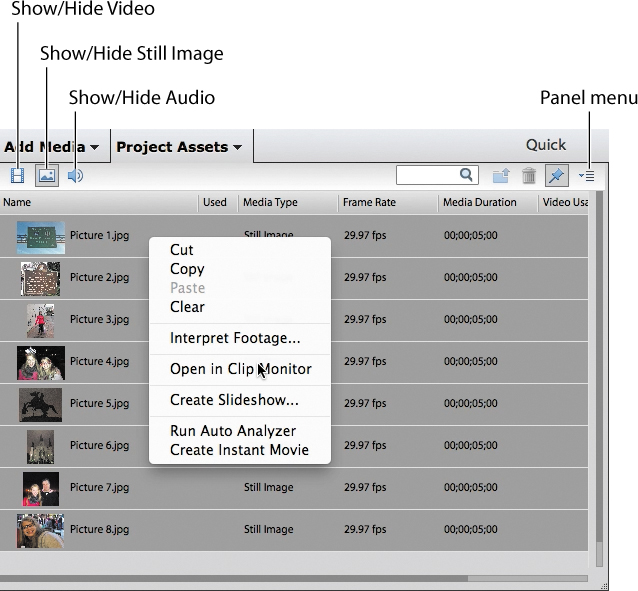
3. Click Picture 1.jpg, press the Shift key, and then click Picture 8.jpg to select all of the pictures. Scroll down to Picture 8.jpg if necessary. Note that if you press Ctrl+A (Windows) or Command+A (Mac OS) to select all of the photos, you’ll select all the content in the Project Assets panel, including video and audio content, not just the photos.
![]() Note
Note
Only the Take Video Only choice will be available here, because you’re selecting pictures rather than video files with audio.
4. Right-click any selected image, and choose Create Slideshow. If the Smart Fix dialog box appears, click No. The Create SlideShow dialog box opens, and includes several options:
• Ordering (Sort Order or Selection Order)
• Media (Take Video And Audio, Take Video Only, or Take Audio Only)

• Place Images/Clips At Unnumbered Markers (grayed out now because the project has no markers)
• Image Duration
• Apply Default Transition
• Transition Duration
For this exercise, use the default settings.
5. Click OK to create the slide show. Adobe Premiere Elements inserts the slide show with transitions at the end of the Video 1 track.
Working in Smart Trim mode
The Smart Trim editing mode can help you identify suboptimal regions within your videos so you can either fix or delete them. Smart Trim relies on information gathered while Adobe Premiere Elements analyzes your clips, so you must Auto-Analyze your clips before entering Smart Trim mode. You can operate Smart Trim either automatically or manually, although we recommend that you use Smart Trim manually until you understand how it works.
You can work with Smart Trim in Quick and Expert views; this exercise demonstrates how it works in Expert view, so click Expert (![]() ) at the top of the Monitor panel, if necessary, to enter that view. Click the Fit To Visible Timeline icon (
) at the top of the Monitor panel, if necessary, to enter that view. Click the Fit To Visible Timeline icon (![]() ) at the extreme right of the Monitor panel to spread the clips over the timeline. Then click Tools, and then click Smart Trim. If you haven’t run the Auto-Analyzer, Adobe Premiere Elements will run it now.
) at the extreme right of the Monitor panel to spread the clips over the timeline. Then click Tools, and then click Smart Trim. If you haven’t run the Auto-Analyzer, Adobe Premiere Elements will run it now.
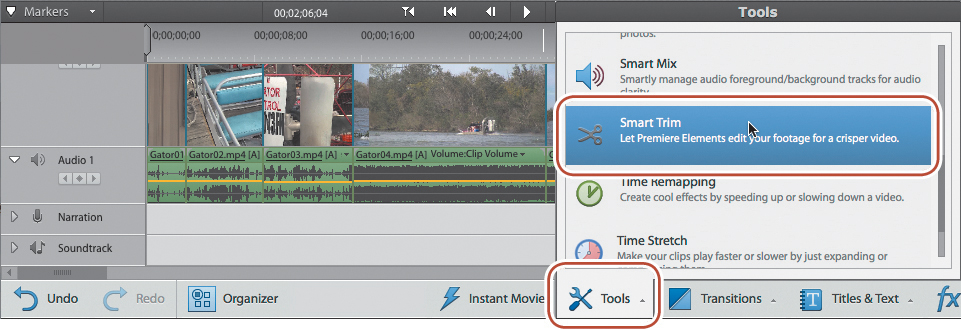
As you can see in the figure below, Smart Trim identifies problem areas via a zebra pattern. If you hover your mouse over the zebra pattern, a tool tip details the problems with the clip. You have multiple options regarding any clip, or portion of a clip, that Adobe Premiere Elements flags as a problem area. Not surprisingly, since a substantial portion of these videos was shot from a moving airboat, Adobe Premiere Elements found lots of shaky footage.
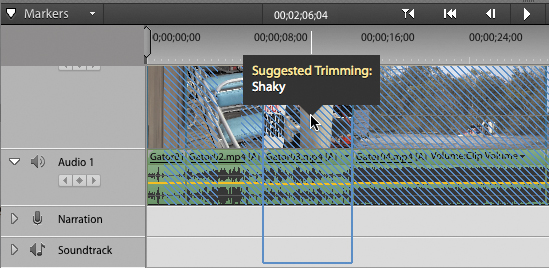
You can right-click the clip, and choose Trim, Keep, or Select All. Trim will delete the selected portion; Keep will retain it and turn off the zebra striping; Select All will select multiple suboptimal regions within the same clip so you can trim or keep them all. In addition to these options, you can trim away any or all of the suboptimal portions of your clip by clicking and dragging an edge to the desired new starting point, just as you would trim any other clip in the timeline.

Smart Trim options

You can also trim a scene by adjusting the smart trim options (click the Smart Trim Options button in the upper right corner of the Monitor panel). Let’s view the available choices.
In the Smart Trim Options dialog box, Adobe Premiere Elements uses two variables to identify suboptimal clips: Quality Level and Interest Level. Quality Level is simple to understand: If a clip is shaky or blurry, has poor contrast or lighting, or has other deficits that mar quality, Adobe Premiere Elements identifies the clip in Smart Trim mode as being below the Quality Level threshold, depending on how flawed the clip is and where you positioned the Quality Level slider.
By contrast, Interest Level analyzes qualities, such as the amount of motion in a clip, the presence or absence of dialogue, and other criteria that identify clips that are interesting to watch. If you shot a picture of a blank wall that was sharp, well lit, and completely stable, the Quality Level would be perfect, but Adobe Premiere Elements would flag it as lacking in the Interest Level department. That doesn’t do much for those boring conversations with Uncle Harold, because if quality is good, and the audio level sufficient, Smart Trim wouldn’t flag the content, so you’ll still have to delete those manually.
You can adjust the sliders to set the tolerance levels for either criteria: Moving the slider to the left increases the threshold for suboptimal clips, so that fewer and fewer clips will be flagged. Moving it to the right reduces the threshold so that more clips will be flagged.
For example, if you examine the clips in your project and find that most clips flagged by Adobe Premiere Elements look good to you, move the slider to the left, and Adobe Premiere Elements will set the threshold higher and flag fewer clips. If clips left unflagged in Smart Trim mode look suboptimal to you for either Quality Level or Interest Level reasons, move the slider to the right.
Operating modes
There are two operating modes in the Smart Trim Options dialog box: Manual and Automatic. In Manual mode, which is the default, Adobe Premiere Elements displays all suboptimal regions of a clip via the zebra stripes discussed previously. If you opt for Automatic mode, Adobe Premiere Elements immediately deletes all suboptimal regions present on the timeline. Thereafter, when you drag clips with suboptimal regions to the timeline, Adobe Premiere Elements presents a dialog box asking if it’s OK to remove Smart Trim sections.
There’s an awful lot of bad video out there, and Smart Trim mode presents a very efficient way to identify it. In a real project, when you’ve shot 30–60 minutes of footage and want to quickly isolate the best 3–5 minutes to include in your movie, Smart Trim mode can be a godsend. So check it out on your own projects and see how it works for you.
Two final points: First, when Smart Trim flags quality-related problems, you can either delete the offending sections or try to fix them, which you’ll practice in Lesson 6. So even if you decide to leave suboptimal clips in the project, Smart Trim helps by identifying sequences you can improve with corrective effects.
Second, to reiterate a comment made earlier, you should not use Smart Trim in Automatic mode. Lots of “must have” sequences in your movies—such as your son blowing out the candles on his birthday cake or your daughter accepting her diploma—may not meet Adobe Premiere Elements’ quality thresholds, but you still don’t want to delete them. In Automatic mode, you don’t get that choice.
That’s all for this exercise, so you can cancel out of the Smart Trim Options dialog box and exit the project if you’d like, or continue working in the project.
Wonderful! You’ve finished another lesson and learned how to cut, trim, split, and arrange your raw video into a cohesive movie. In the next few lessons, you’ll polish it into a fine-tuned production.
Review questions
1. What are the key differences between Expert and Quick views from an editing perspective?
2. What are an In point and an Out point, and what can you do with each?
3. What are two methods of shortening your video clips?
4. How does Adobe Premiere Elements combine video tracks at the same position on the timeline?
5. What are the two criteria assessed by Adobe Premiere Elements in Smart Trim mode?
Review answers
1. One of the most significant differences between Expert and Quick views is the ability to see the Project Assets panel. In Quick view, you can add content to the end of projects only via program controls, although you can drag and drop to add content to the middle of a project. In Expert view, you can drag content from the Project Assets panel to anywhere in the project.
2. An In point is the first frame of your clip as shown in Quick or Expert views and the Out point is the last frame. In and Out points can be moved to create a shorter or longer clip.
3. You can shorten your clips by trimming their In points and Out points or by splitting the clip and deleting unwanted portions.
4. Adobe Premiere Elements renders tracks from the top down. Any opaque areas of the clip in the Video 2 track will cover the view on the clip in the Video 1 track. Conversely, the clip in the Video 1 track will show through any transparent (or reduced opacity) areas of the clip in the Video 2 track.
5. Quality Level and Interest Level are the two criteria used in Smart Trim mode. The former assesses picture and audio quality on a technical level; the latter assesses multiple qualities, such as the amount of dialogue and motion, that tend to indicate whether or not a clip is interesting.


